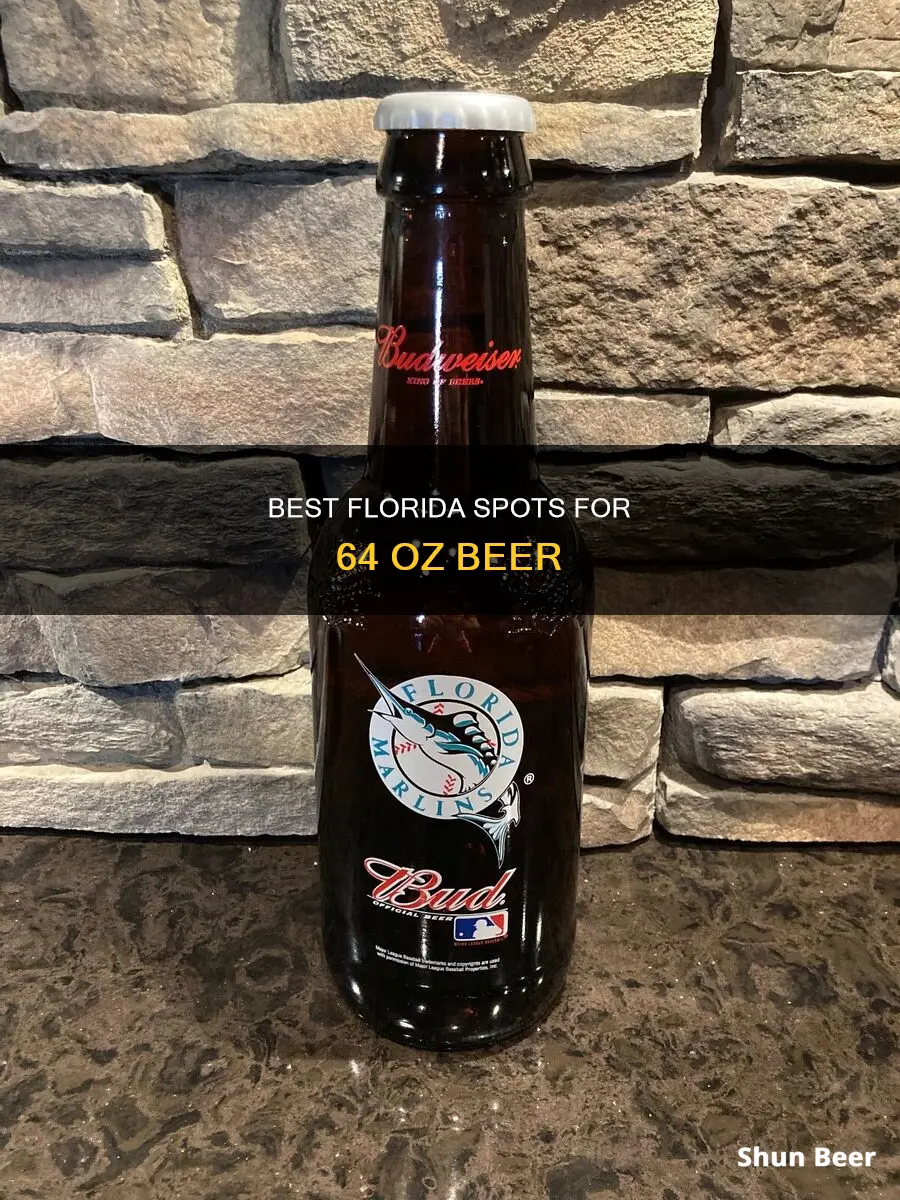
Florida has had a ban on 64-ounce growlers, which has been described as one of the most bizarre alcohol regulations in the country. The law prevented breweries from selling the industry-standard size, creating a headache for both entrepreneurs and consumers. However, as of July 1, 2015, Florida legalized 64-ounce growlers, allowing breweries to sell the popular size to customers. This change brought Florida in line with 47 other states that permitted the sale of this size. Now, customers in Florida can purchase 64-ounce growlers from various breweries and even celebrate the legalization with special events and limited-edition releases.
| Characteristics | Values |
|---|---|
| Date of legalisation of 64-ounce growlers in Florida | 1st July 2015 |
| Previous law | Beer containers could be sold in sizes of 8, 12, 16 or 32 ounces, or over a gallon. |
| Industry standard | 64-ounce growlers are the industry standard |
| Benefits of 64-ounce growlers | Reduced costs, increased sales and more jobs |
| Other states | 47 other states allowed the sale of 64-ounce growlers |
What You'll Learn

Florida's 64-ounce beer ban
The 64-ounce growler, being the industry-standard size, was particularly popular among craft breweries and their customers. The ban on this size of container created a lot of frustration for both brewers and beer enthusiasts in Florida. The law prevented brewpubs from selling beer to go and even restricted breweries to only selling growlers with their logo on them.
The ban was initially put in place in 1965, allegedly as a response to Miller Brewing Co. deciding to build a brewery in Georgia instead of Florida. At the time, Miller's 7-ounce pony bottles were very popular, and this law prevented them from distributing those bottles in Florida. In 2001, Senator Tom Lee led a change to the law, allowing beer to be sold in any container size under a quart or over a gallon. However, this change unintentionally created a loophole where beer could be sold in gallon-sized containers, which are much larger than the 64-ounce growlers.
Craft brewers in Florida advocated for the legalisation of 64-ounce growlers, arguing that it would reduce costs, increase sales, and create jobs. They also pointed out that the ban made little sense in terms of preventing excessive drinking, as consumers could still purchase two 32-ounce growlers or a 128-ounce growler. The movement to legalise the 64-ounce growler gained momentum, and on July 1, 2015, Governor Rick Scott signed legislation to lift the ban. This change was celebrated by craft breweries and beer enthusiasts across the state, who saw it as a victory over "Big Beer" and a boost for small local businesses.
The Ultimate Beer Gift Guide for Beer Connoisseurs
You may want to see also

The repeal of the ban
The push to legalize 64-ounce growlers in Florida was led by craft brewers, who had been advocating for changes to the law for years. They argued that the ban was senseless, as consumers could purchase two 32-ounce growlers or a 128-ounce growler but not the industry-standard half-gallon size. This restriction created unnecessary obstacles for businesses and confused tourists, who suspected they were being ripped off.
The movement to repeal the ban gained momentum with the support of Senator Tom Lee, who introduced a bill in 2001 to allow beer to be sold in any container size under a quart or over a gallon. While this bill marked a significant step forward, it notably excluded the 64-ounce growler, which was gaining popularity among craft breweries at the time. Senator Lee defended this restriction as a measure to prevent overconsumption.
However, craft brewers and their supporters persisted in their efforts to legalize the 64-ounce growler. They argued that allowing its sale would boost revenues for craft breweries and provide consumers with more options for consuming beer at home. Finally, on July 1, 2015, the ban was officially lifted when Governor Rick Scott signed the legislation into law. This change eliminated a burdensome regulation and created a more favorable environment for Florida businesses, particularly craft breweries.
Where to Buy Tooheys Beer in the USA
You may want to see also

Growlers defined
Growlers are portable, refillable vessels used for transporting beer. They are typically made from glass, steel, or ceramic, and are designed to be filled with draft beer from breweries or bars. The term "growler" is believed to originate from the 1800s, when metal pails or buckets were used to transport beer from taverns to people's homes. Over time, the term has come to refer to a variety of container types, including glass jugs, ceramic containers, and stainless steel bottles.
Growlers are known for their convenience and ability to keep beer fresh. They are often sealed with a twist-cap or a special lid that helps preserve carbonation and maintain flavour. This makes them ideal for enjoying draught beer at home or on the go. Additionally, growlers come in various sizes, with the standard size being 64 ounces or half a gallon. This size was previously banned in Florida, but the restriction was lifted in 2015, allowing residents to join the rest of the nation in enjoying the benefits of this popular container size.
The history of growlers is quite fascinating and dates back to the early days of beer consumption. In the 1800s, thirsty townspeople would carry metal pails lined up at their local tavern to fill up with beer. These pails were known for the rumbling or growling sound they made as carbon dioxide escaped through the lid. This is believed to be the origin of the term "growler."
Over time, the design and materials used for growlers have evolved. During Prohibition, their use was outlawed in some places, and they were replaced by waxed cardboard containers in the 1950s and 1960s. However, the modern growler as we know it today gained popularity in the late 1980s when Charlie and Ernie Otto opened their draft-only microbrewery in Wyoming. They revived the concept by using glass jugs with their brewery's logo, and the growler culture was reborn.
Today, growlers are widely embraced by beer enthusiasts for their practicality and eco-friendliness. They offer a cost-effective way to enjoy fresh draught beer without the waste associated with bottles or cans. Growlers can be purchased or refilled at breweries, bars, and even some grocery stores, depending on local regulations.
In summary, growlers are an essential part of the beer culture, offering convenience, freshness, and a unique drinking experience. Their history is intertwined with the evolution of beer consumption, and they continue to be a popular choice for beer lovers across the nation, including in Florida, where the 64-ounce growler is now legal.
Best Time to Buy Beer in Walker County, Georgia
You may want to see also

Florida's beer laws
Until 2015, Florida was one of only three states in the US where the 64-ounce growler was banned. This was due to a law passed in 1965 that restricted beer containers to 8, 12, 16, or 32 ounces. The legislation is rumoured to have been a response to Miller Brewing Co.'s decision to build a brewery in Georgia instead of Florida. In 2001, Senator Tom Lee led a successful charge to allow beer to be sold in any size container under a quart or over a gallon. However, this change unintentionally created a loophole that allowed beer to be sold in containers of up to a quart or a gallon or more, but not in between. This meant that 40-ounce bottles and 64-ounce growlers were illegal.
In 2015, Florida finally eliminated this bizarre regulation, and the 64-ounce growler was legalised. This was a symbolic win for Florida's craft breweries, who had been fighting to change the law for years.
Other Florida beer laws include:
- Beer, wine, and liqueurs can be purchased in retail stores, grocery stores, and convenience stores. Spirits are only available in retail package stores.
- Bars and restaurants stop serving alcohol between 1 a.m. and 7 a.m.
- Alcohol is not usually sold on Sundays, although some counties are licensed to sell alcohol 24 hours a day, seven days a week.
- The legal drinking age in Florida is 21.
- Open containers of alcohol must be carried in a vehicle's trunk.
- The maximum blood-alcohol content (BAC) for drivers is .08 percent. Underage drivers (21 or younger) have a maximum BAC of .02 percent.
- Alcohol sales are subject to a number of taxes, including a general sales tax of 6% and a tax of $6.50 per gallon of spirits.
Buying Beer in Martinsville, VA: What Time Restrictions Apply?
You may want to see also

Beer laws in other states
Beer laws in the United States vary significantly from state to state. The Twenty-first Amendment grants each state and territory the power to regulate alcohol within their jurisdiction, and these laws can cover the production, sale, distribution, and consumption of alcohol.
For example, Florida had a ban on 64-ounce growlers, which was repealed in 2015. This was considered one of the most bizarre alcohol regulations in the nation, as the half-gallon size was standard across other states. Florida also has a three-tier system, which requires brewers to use a distributor to get their product to consumers, increasing costs.
Some other states with notable beer laws include:
- Texas, which passed a sale restriction in 2013 that forces craft brewers to give up their distribution rights to distributors for free.
- Indiana, which prohibits the sale of cold beer by grocery stores or gas stations.
- Arizona, where it is illegal to purchase more than 50 ounces of beer, 1 liter of wine, or 4 ounces of distilled spirits at one time.
- Kansas, which has some of the strictest alcohol laws in the country, including prohibiting all alcohol from 1881 to 1948.
- Nevada, which has very few restrictions on the sale and consumption of alcohol, with no open container law, no public intoxication law, and no dry counties.
- Missouri, which has no open container law, no public intoxication law, and no dry counties. Additionally, minors can consume alcohol with parental supervision.
The number of regulations imposed by each state on the production and distribution of beer also varies. For example, California has the most regulations at 25,870, while South Dakota has the fewest at 1,177.
Hudson, Wisconsin: Late-Night Beer Buying Options
You may want to see also
Frequently asked questions
As of July 1, 2015, 64 oz beers (also known as growlers) are legal in Florida. You can buy them from breweries to take home.
The 64 oz beer was banned in Florida due to a law passed in 1965 that restricted beer containers to specific sizes: 8, 12, 16, or 32 ounces.
Florida craft brewers had been fighting to change the law for years. In 2001, Senator Tom Lee led a major change to the restrictions, allowing beer to be sold in any size container under a quart or over a gallon. However, this change unintentionally banned sizes in between, including the 64 oz container. Finally, in 2015, the ban on 64 oz beers was lifted.
Legalizing 64 oz beers provides added revenue for breweries and gives consumers another option for consuming beer at home. It also symbolizes a win for small local craft breweries, showing that they can band together for meaningful change.
Yes, there are a few restrictions to note. Breweries can only fill a 64 oz growler if it has their logo on it. Additionally, the beer inside the growler must be identified with a sticker or a tag tied to the handle. Growlers of any size can only be sold for off-premise consumption and cannot be drunk on-site.







